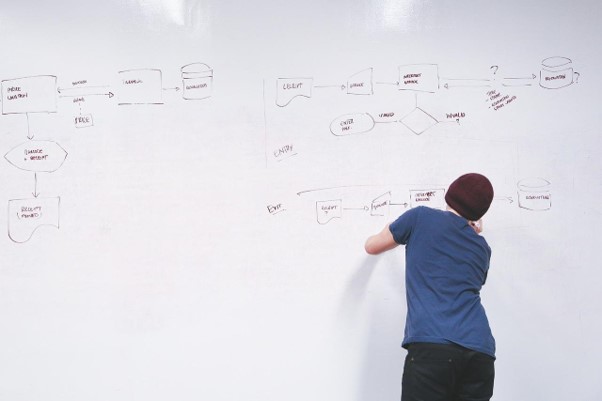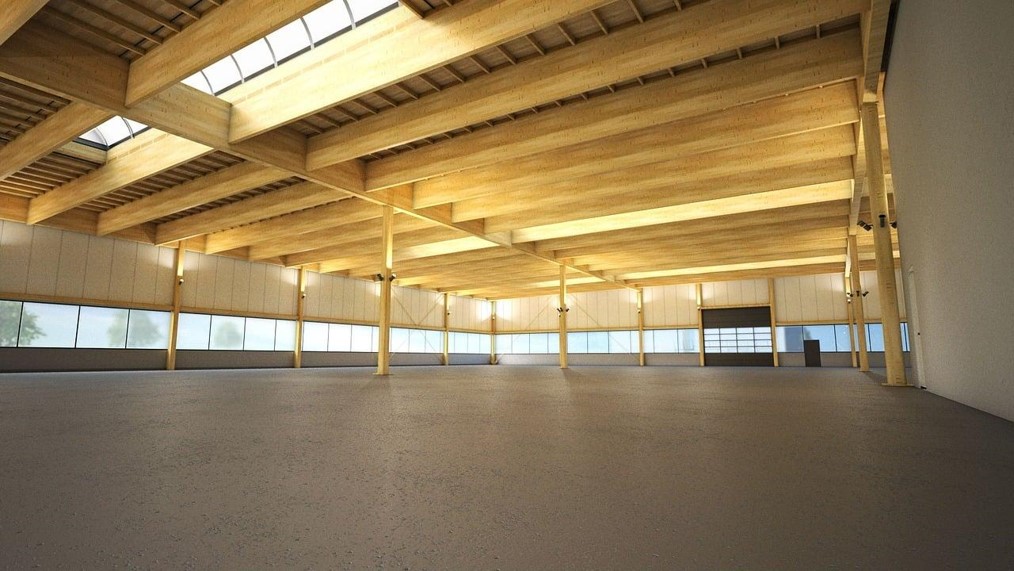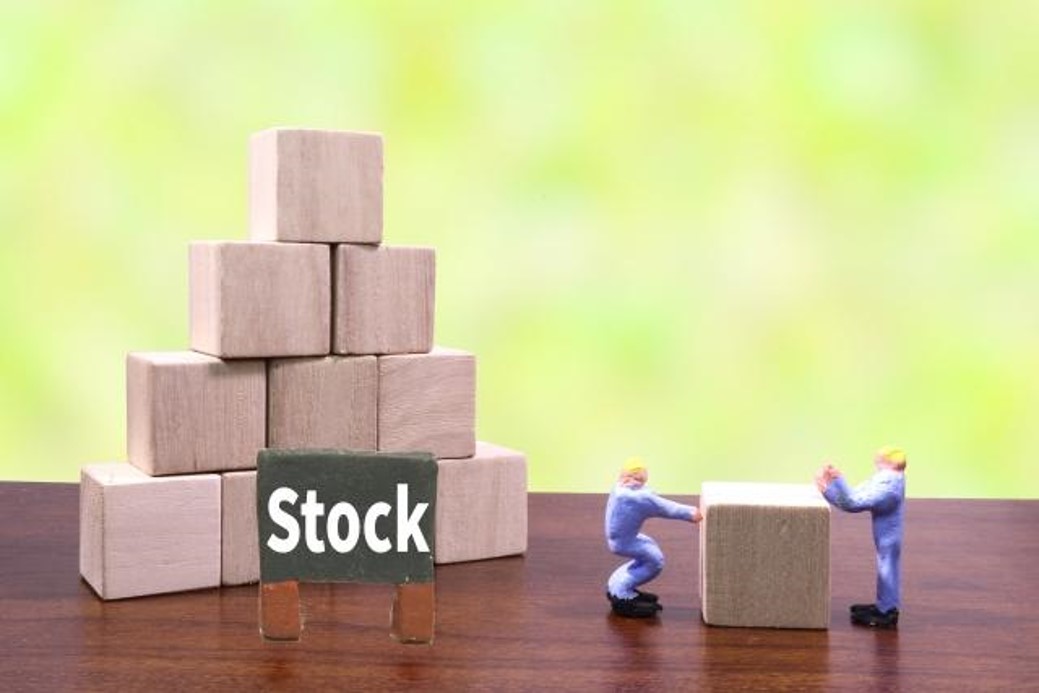

MakMax Plus
What facilities are legally required for contaminated soil treatment operations? Requirements and types of tents and temporary roofs
2020.09.09
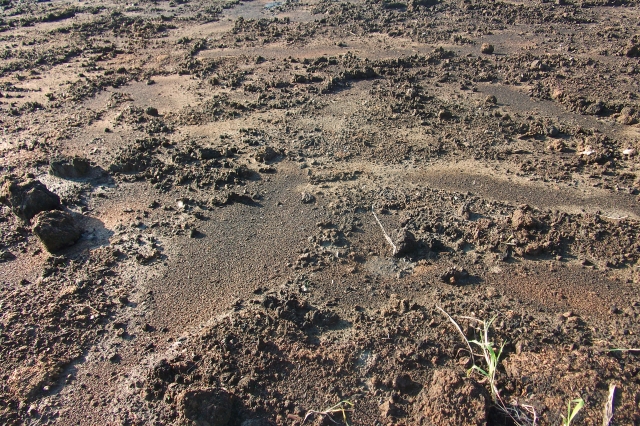
In Japan, soil contamination associated with industrial development has become a social issue since the Meiji era. The problem of soil contamination by hazardous substances is spreading in various areas around us, from agricultural land to urban areas, and various measures have been taken to date.
Now that the actual condition of contaminated soil has been clarified, methods have been established for the treatment of contaminated soil. Since hazardous substances are handled, laws and regulations with various standards have been established to ensure strict handling of these substances, and compliance with these rules is required.
This article describes the requirements for contaminated soil treatment operations and the equipment used to perform them. We will also introduce the specifics of tents and temporary roofs, which are the most important of these facilities.
Please use this information as a reference when preparing for contaminated soil treatment.
Table of Contents
1 What is contaminated soil treatment work?
2 Dedicated facilities are required depending on the nature of the contaminated soil treatment work.
2-1 Types of contaminated soil treatment facilities (Article 22, Paragraph 2, Item 3 of the Law and Article 1 of the Ministerial Ordinance on Treatment Business)
3 Requirements for facilities for contaminated soil treatment operations, etc.
4 Tent and temporary roof for contaminated soil treatment by Taiyo Kogyo
4-1 Shatterproof tents
4-2 Dust diffusion prevention tent containing hazardous materials
4-3 Telescopic tents
4-4 New type telescopic temporary tent
4-5 Fixed Tents
5 Conclusion
What is contaminated soil treatment work?
Check it out from the definition of “contaminated soil”.
Contaminated soil is soil (soil) that contains certain hazardous substances (heavy metals, organic solvents, pesticides, oil, etc.) in excess of standard values that are harmful to the human body and the environment. Soil contaminated with hazardous substances poses a risk of adverse effects on the human body, organisms, and the natural environment if the soil is directly ingested or if groundwater, etc. leached from the soil is consumed. Therefore, contaminated soil needs to be properly treated instead of being left untreated, and contaminated soil treatment work is ongoing and needed in many areas to protect the community and the environment.
To establish these standards, a law called the “Soil Contamination Countermeasures Law” was enacted in 2003. This law, which aims to assess the status of soil contamination and prevent human health hazards caused by soil contamination, includes the following items.
- Criteria for land that is subject to the obligation of soil contamination investigation
- Target specific hazardous substances and their standard values
Nowadays, contaminated soil treatment operations must be carried out in accordance with this law. In addition, a ministerial ordinance titled “Ministerial Ordinance on Contaminated Soil Treatment Business (hereinafter referred to as “Ministerial Ordinance on Treatment Business”)” has been issued in accordance with the contents of the “Soil Contamination Countermeasures Law”. In addition, the “Guideline for Contaminated Soil Treatment Business” has been prepared to serve as a reference guide for local governments and businesses involved in the practice.
In accordance with the provisions of these various laws and regulations, it is necessary to check the equipment required for contaminated soil treatment operations.
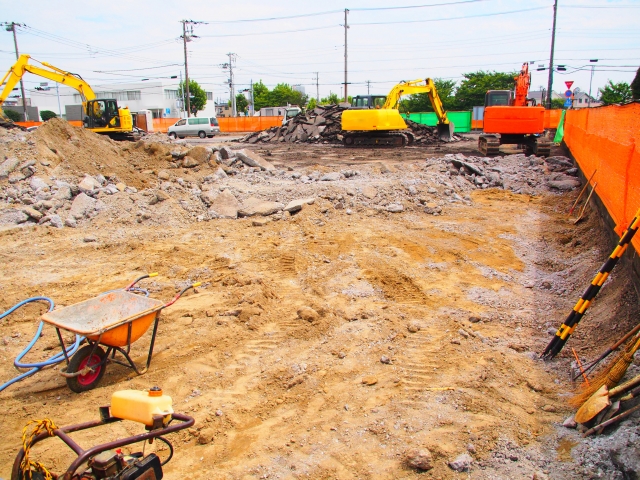
Dedicated facilities are required depending on the nature of the contaminated soil treatment work.
Various rules for contaminated soil treatment operations are set forth in laws and regulations. Because the toxic substances (contaminants) that cause contaminated soil vary widely, the treatment work also varies.
And, depending on the nature of the processing work, it is stipulated that a dedicated processing facility is also required. The types of treatment facilities specified include the following
Type of contaminated soil treatment facility (Article 22, Paragraph 2, Item 3 of the Law and Article 1 of the Ministerial Ordinance on Treatment Business)
purification and other treatment facilities
Facilities for purification, melting or insolubilization of contaminated soil
Cement production facility
Facility to produce cement by using contaminated soil as raw material
landfill
Facilities for reclamation of contaminated soil
sorting and other treatment facilities
Facilities for separating rocks, concrete debris, and other materials from contaminated soil and for adjusting the moisture content of contaminated soil.
Requirements for facilities for contaminated soil treatment operations, etc.
As mentioned above, there are dedicated facilities required depending on the nature of the contaminated soil treatment work. And as for their facilities, each has its own detailed set of requirements. A summary of its contents is organized as follows.
Structural safety (Article 4, Item 1 (c) of the Treatment Business Ordinance)
Contaminated soil treatment facilities must operate stably throughout the year. The structure shall be structurally safe against dead weight, loading, water pressure, earth pressure, wind pressure, snow loads, seismic force, thermal stress, etc. As required, the product must have properties such as abrasion resistance, corrosion resistance, and heat resistance.
Corrosion prevention measures (Article 4, Paragraph 1, D of the Ministerial Ordinance on Treatment Business)
Exhaust gas and wastewater from decomposition treatment and chemicals used in treatment may contain corrosive substances, and corrosion prevention measures must be taken to ensure that these do not affect the contaminated soil treatment facility.
Structure to prevent dispersal, underground seepage, and odor emission (Article 4, Item 1 (e) of the Ministerial Ordinance on the Treatment Business)
The site where the contaminated soil treatment facility is to be constructed must have the necessary structure or equipment to prevent the dispersal of specified toxic substances, seepage into the ground, and emission of foul odors.
Prevention of significant noise and vibration (Article 4, Item 1 (f) of the Ministerial Ordinance on the Treatment Business)
The operation of various equipment at the contaminated soil treatment facility may cause significant noise and vibration, which may affect the surrounding living environment. Therefore, depending on the conditions of the surrounding environment of the contaminated soil treatment facility, it may be necessary to adopt low-noise equipment or install soundproof walls.
Effluent treatment facilities, etc. (public waters) (Article 4, Item 1 (g) of the Ministerial Ordinance on the Treatment Business)
When discharging effluent into public waters, facilities must be provided as specified by the Ministerial Ordinance for the treatment industry.
Effluent treatment facilities, etc. (Sewerage) (Article 4, Item 1 (h) of the Ministerial Ordinance on Treatment Business)
When using the sewage system to eliminate wastewater, it is also necessary to provide facilities as specified by the Ministerial Ordinance for the Treatment Industry.
Groundwater monitoring facilities (Treatment Industry Ordinance, Article 4, Item 1 (i) (li))
A measurement facility is needed to determine the contamination status of groundwater around the perimeter of the treatment facility. However, if the specified measures are taken to prevent underground seepage, the measurement equipment and measurement itself are not required.
Atmospheric Hazardous Substance Treatment Facilities, etc. (Article 4, Item 1.1.1.1 of the Ministerial Ordinance on Treatment Business)
When air toxic substances are emitted into the atmosphere from the discharge outlet of a purification or cement manufacturing facility, the facility must be equipped with the necessary air toxic substance treatment facilities and must also be equipped with air toxic substance measurement facilities to ensure that the amount of toxic substances does not exceed the permissible limits.
Taiyo Kogyo's tents and temporary roofs for contaminated soil treatment
We have explained the various requirements for facilities for contaminated soil treatment operations. To carry out contaminated soil treatment work, facilities and equipment that meet many requirements are required, but arranging such facilities and equipment on a case-by-case basis can be quite a time-consuming and burdensome task.
Therefore, at the end of this article, we will introduce the lineup of tents and temporary roofs manufactured by Taiyo Kogyo Corporation as an example of equipment that can reduce such burdens.
Shatterproof Tent
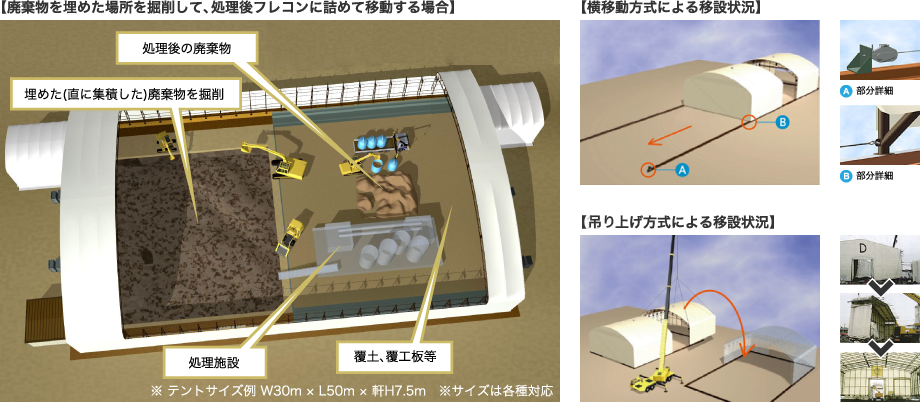
As the name suggests, Taiyo Kogyo’s “scattering prevention tents” are used to prevent contaminants from scattering into the surrounding area. The following article describes in detail the cases where shatterproof measures are required.
It is characterized by free design and high design quality that takes into account the purpose and environment, and is the culmination of Taiyo Kogyo’s know-how, which has been used in a wide variety of sites. Smooth movement is possible, including lateral movement along rails and lifting and moving with a crane. The roof unit can be moved with a crane or winch, so even large-area sites can be handled without problems.
Even for large-span facilities (W15 to 30 meters), the structure is designed for easy relocation, which can be expected to significantly reduce the total cost of relocation.
Tents to prevent the diffusion of dust containing hazardous materials
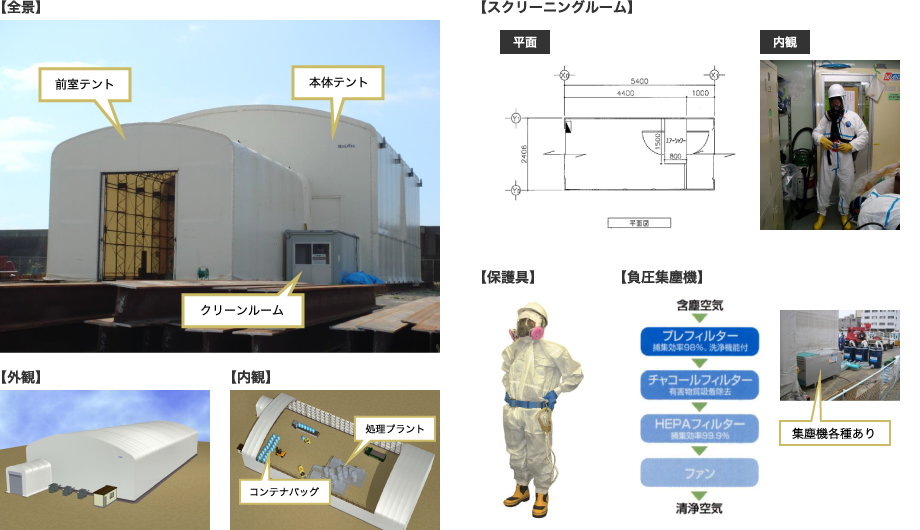
The “Dust Diffusion Prevention Tent Containing Hazardous Materials” is equipped with various facilities to prevent dust generated by contaminated soil treatment work from dispersing and diffusing into the surrounding area. We can handle contamination levels from level 1 to level 3, depending on the site. It is characterized by very high quality because it is built with worker safety as a top priority by providing front rooms and clean rooms, screening rooms in changing rooms, and negative pressure dust collectors to clean air containing contaminated soil dust.
Telescopic Tents
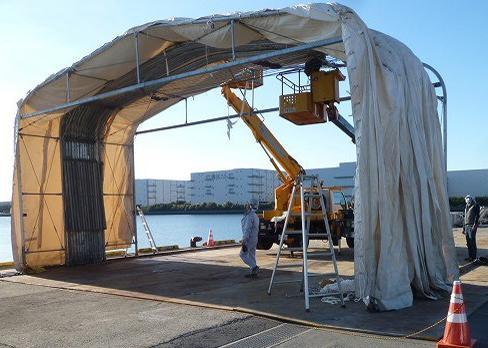
A “telescoping tent” is a type of tent whose size can be adjusted by expanding and contracting the tent frame itself. The size of the tent can be adjusted according to the movement and progress of the work area and the environment in which the tent will be used, and it can be used for a wide range of applications and for long periods of time in a single installation. Expansion and contraction of sheds can be handled manually without the use of machinery, and the lack of heavy equipment reduces costs.
Five different frontage sizes are available, so the appropriate size can be selected for each site, and even long or large items can be smoothly entered or removed from the warehouse. Installation can usually be completed in 1 to 4 days per building, and removal can usually be completed in 1 to 2 days, shortening the overall construction period.
New Telescopic Temporary Tent
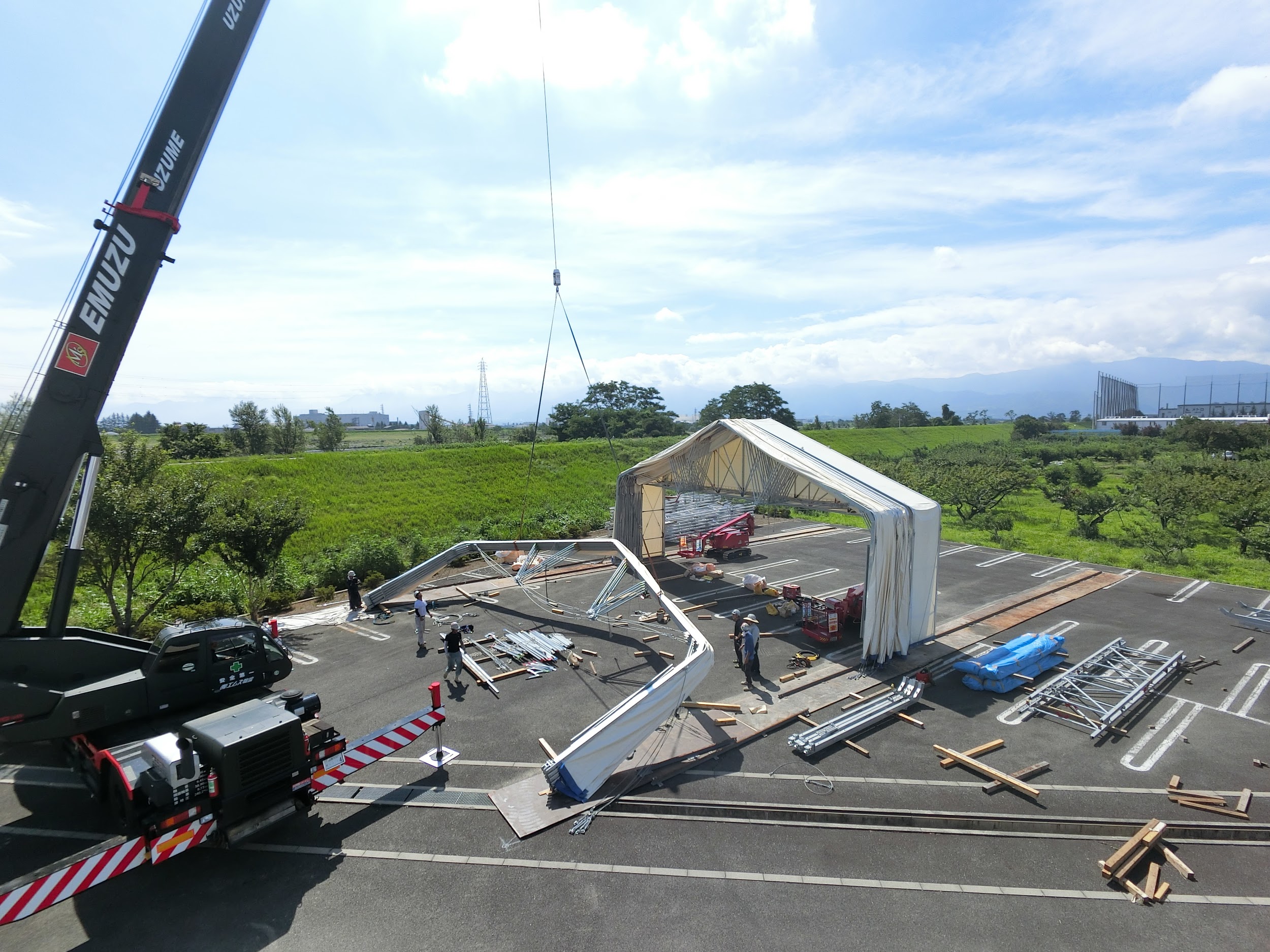
The “New Telescopic Temporary Tent” has a structure that allows the tent to be inserted span by span as needed. Sheds can be rented only for the required area, creating a cost structure with no waste. The dimensions in the girder direction can be freely set for each span (1.5 m), allowing for flexibility according to the application and situation.
The opening is of the curtain type, and can be fully opened by simply sliding it in and out, allowing for speedy loading and unloading. Tent installation is simply a matter of inserting and sliding the split membrane along the guide fasteners, which improves construction and safety compared to older models.
Fixed Tent
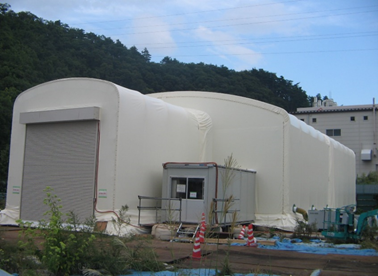
This is a fixed-size tent that can easily provide large storage space. In cases where there is no need to resize or relocate, the structure allows for a large space without intermediate pillars and an eave height of 7.5 m, allowing for the storage of many loads with room to spare. It is available as a warehouse for high-performance storage and can be built in a short period of time.
The building is compliant with the Building Standard Law, so building permit applications can be submitted.
summary
Facilities and equipment for contaminated soil treatment operations are subject to strict standards. Since we will be dealing with hazardous materials, it is only natural that there are many things to consider, but many local governments and business personnel may have their heads in the sand.
Taiyo Kogyo Corporation’s tents and temporary roofs are available in a wide variety of types and with diverse functions to meet legal compliance. If you are considering or worried about this, please feel free to contact us for a consultation.
Official Website: Taiyo Kogyo Corporation
Tent Warehouseへの
Any Inquries

What you need to know when building a warehouse
We packed it all in.
Clues to solving the 2024 problem
Recommended for
I don't know where to start in building a warehouse.
I want to build a warehouse in an economical way.
Which type of warehouse should we build?
I want to learn the basics of warehouse construction anyway.
I'm concerned about the 2024 problem, but I don't know what to do about it.
Related Articles
- TOP>
- MakMax Plus>
- What facilities are legally required for contaminated soil treatment operations? Requirements and types of tents and temporary roofs






